What’s more intimidating than a creature that looks like it inherited more than a few genes from Godzilla? To say that snapping turtles are mean-looking monsters is an understatement; these things look like they’re ready to break your bones and feast on your flesh.
But are snapping turtles really as dangerous as they look?
The quick answer is no. On the contrary, these creatures are generally docile and shy; they’d rather stay away from us humans than attack us. In fact, unless you give a snapper a reason to hurt you, it’ll leave you alone.
However, one could accidentally stumble upon a snapper and startle it. Or another could try to touch a snapper on the head without realizing the damage such creatures are capable of. In such cases, this reptile can harm you – which is why you need to take extra care whenever you’re in any area frequented by these animals.
Read on to know more about snapping turtles and whether or not they’re dangerous!
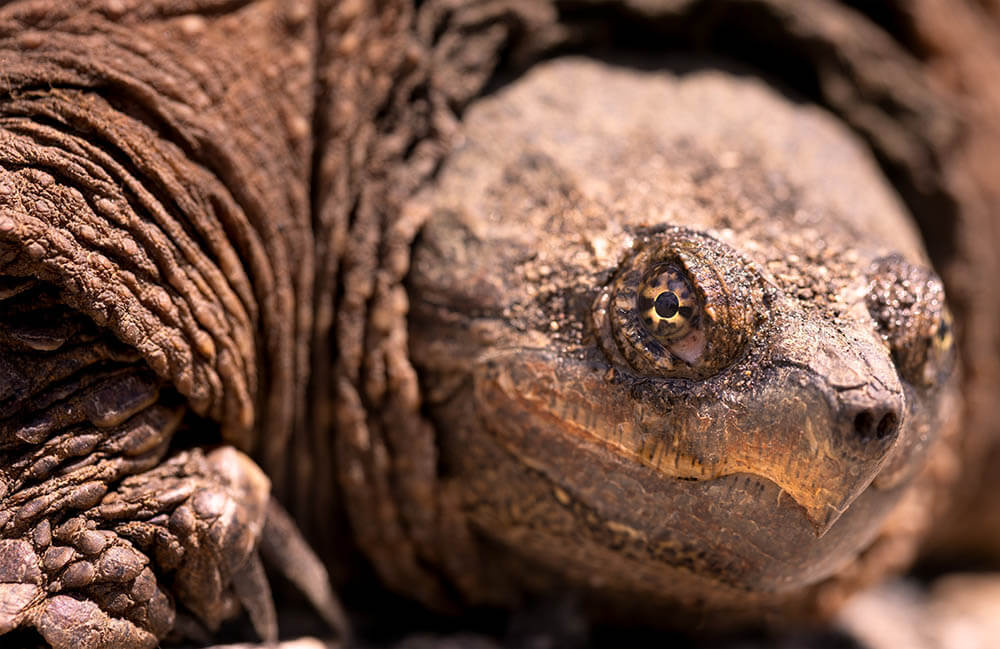
What You Need to Know About Snapping Turtles
The key to understanding why a snapping turtle would bite you is understanding the snapping turtle itself. And this knowledge, in turn, can help you avoid getting harmed by this creature.
With that in mind, let’s get to know this amazing animal a little better!
1. It sees you as the predator
Snapping turtles are predatory animals that consume other critters. Thankfully, they’re too small to see us humans as prey. A snapper therefore won’t stalk or ambush you in the hopes of killing you for food. It’s far too slow on land to chase you. And even when you’re both in the water, where these creatures are far quicker and have greater freedom of movement, it would rather steer clear of you as it has no interest in dining on your flesh.
The fact is, snapping turtles see us as dangerous. To them, we’re big, scary, and unpredictable beasts that can easily overpower and kill them. This is why if we get too close to one of them, it goes on the defensive, which entails trying to scare us away by hissing and biting us if we insist on bothering it.
It’s for the reasons above that no one has ever been murdered by a snapping turtle. People have been injured, sure, but only due to accidents and because some of us don’t know any better than to inconvenience a snapper.
2. It’s gentle when not threatened
Snappers may get a bad rap for being savage brutes, but this couldn’t be further from the truth. Like most animals that are smaller than humans, snappers only want to be safe from us.
As mentioned above, a snapper won’t chase you as it has no intentions of killing you and eating you. One that feels safe won’t need to be aggressive toward you and will simply chill in its habitat without bothering you. But even if it feels threatened, it would rather escape than stay and fight you.
A snapper is antsier on land than when in the water. This is because it has an easier time moving in the latter than on the former. When on land, it’s slower and less maneuverable, leaving it more vulnerable to danger and thus more likely to act aggressively toward any human that comes near it. It’s for this reason it’s always a good idea to stay away from a snapper especially when it’s on land.
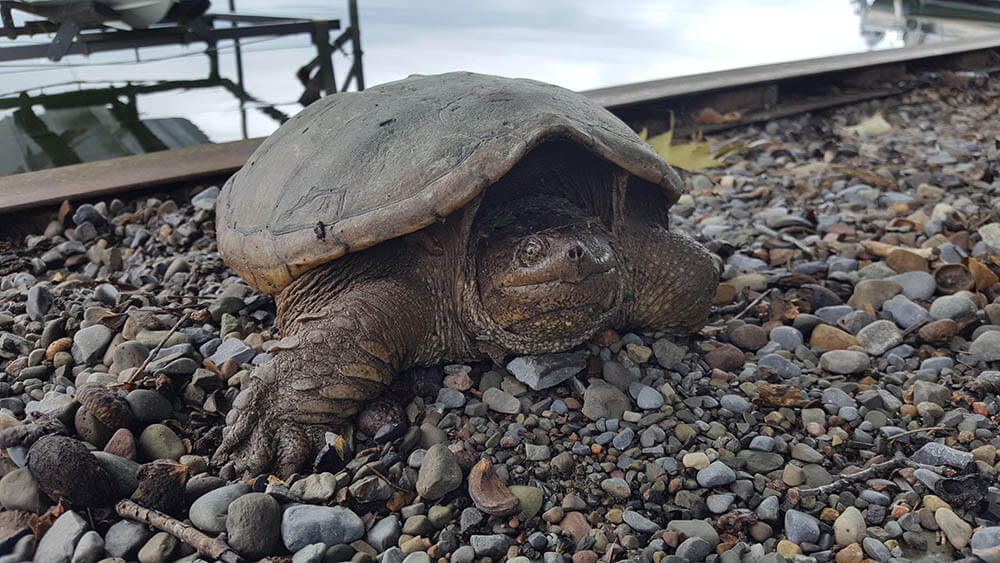
3. It can hurt you and others
Because of its enormous size, the snapping turtle can’t retreat into its shell as effectively as smaller turtles. For this reason, it can’t rely on this technique to keep itself safe from predators.
To make up for this deficiency, the snapper evolved to have a scary face, sharp beak, and powerful bite. The adult common snapping turtle has a bite force of around 209 Newtons, while a mature alligator snapping turtle has a bite force of around 158 Newtons. Both are strong enough to take your fingers off. Thankfully, their jaws can’t open wide enough to wrap around your arm and break your bones. They can still cause painful lacerations, though.
Also, while an adult snapper probably won’t hurt an adult human too seriously, it can do a lot more damage to a child. If you have kids, teach them to respect animals and make sure they never approach a snapping turtle.
Keep your pets away from these creatures, too. A curious dog or cat is small enough that a snapper bite could endanger its life.
You should also remember that snappers have sharp claws. The primary use of these claws is for digging, but they can cause injuries if one of these reptiles accidentally kicks you while it’s struggling to get away from you.
4. It’s a wild animal
Last but not least, snapping turtles are wild animals. They aren’t domesticated, they can’t be tamed, and they remain subject to their wild instincts.
While a dog will hold back from sinking its teeth into you when they’re mad at you, an angry, frightened snapper won’t think twice about taking a bite out of you. Like it or not, even a pet snapper will never feel completely comfortable around you no matter how much food or affection you give it.
Also, keep in mind that training turtles, while possible, is exceptionally tough, and there’s no guarantee your pet snapper will obey you every time you issue a command. Even if you do manage to train one, it can only do the simplest of tricks. So don’t be surprised if you fail to teach your exotic pet to be less cantankerous around you.
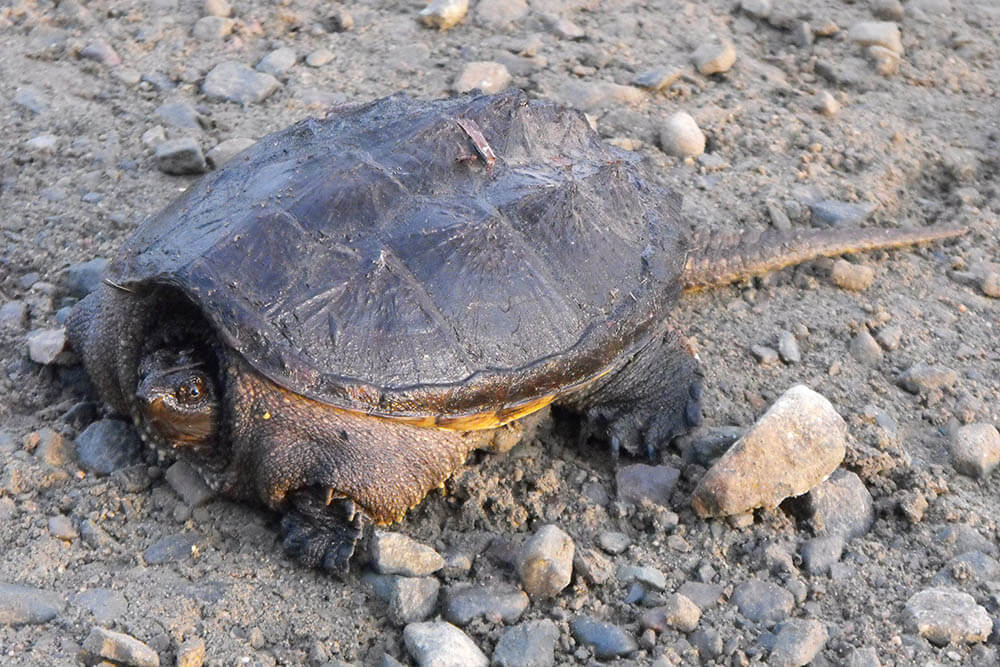
Tips on How to Avoid Getting Bitten by a Snapping Turtle
If you don’t want to be on the receiving end of a snapping turtle bite or scratch, we suggest following the guidelines below:
1. Stay away from it
What’s the easiest and most effective way of preventing getting hurt by a snapping turtle? Simply don’t go anywhere near one. Whether the turtle is on land or in the water, just stay out of its way. And if you accidentally stumble upon one during your walk or dip in a lake, stream, or pond, just walk or swim away from the area.
If you’re curious about this fascinating creature, you can always watch it from a distance; the closer you get to a snapping turtle, the more threatened it’ll feel and the more likely it’ll act aggressively toward you.
2. Stay away from its hiding places
Snapping turtles are found in North America, where they like chilling in the shallow areas of lakes, streams, ponds, and other freshwater or brackish water territories. If you don’t want to get harmed by a snapper, be extra careful in such places or avoid them altogether.
If you do find yourself in such locations, you may spot these creatures partially submerged in the water or resting on logs. However, remain cautious even if you don’t see any turtles. This is because snappers like burying themselves under the soil or silt to conceal themselves from predators as well as prey they’re hoping to ambush. One probably won’t attack you the moment you happen upon it, but stay long enough or irritate it in some way, and it might just feel threatened enough to teach you a lesson.
3. Don’t stay behind it
A snapping turtle can see you best when you’re at its side, which will allow it to watch you and gauge whether or not you’re a threat. So whether you’re just watching the turtle or approaching it, make sure you do so from the side.
If you observe or approach the snapper from behind, it won’t be able to have a good look at you. Therefore, it’ll keep wondering what you’re up to, which can raise its anxiety levels and consequently the likelihood of it getting aggressive.
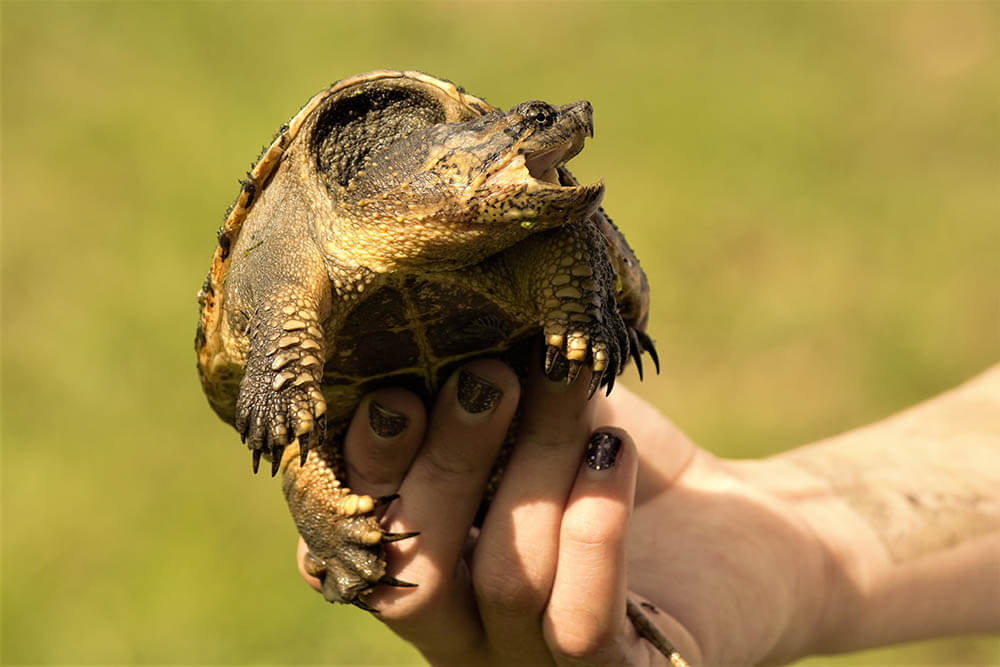
4. Avoid startling it
A startled snapper is a threatened, potentially aggressive snapper, so if you find yourself near one, do your best not to surprise it. Whether the snapper is on land or in the water, don’t make any sudden movements, loud noises, or any other actions that can agitate it. Slowly and quietly move away so it doesn’t perceive you as an enemy it needs to protect itself from.
5. Don’t back it into a corner
Avoid making a snapper feel it has no way to escape except through you.
If you stumble upon one in the water, it can quickly swim away from you. On land, however, these creatures are slower, less able to maneuver, and less confident. If a snapper on land feels trapped, it’ll hold its ground and get bitey to encourage you to leave it alone.
6. Pay attention to its behavior
Is the snapper hissing and opening its mouth wide? Is it releasing a musky scent from behind its legs? These are all signs the creature is stressed out by your presence and is ready to defend itself if needed. If a snapper behaves this way when you’re around, back off.
7. Don’t grab it by the sides of its shell
Approaching a creature that wants to be left alone is bad enough, but grabbing it? You’re only asking for trouble.
If you’re the owner of a pet snapping turtle, however, grabbing your pet can’t be avoided, as you’ll need to do this when transferring it from its enclosure to its feeding space and vice versa. You may also need to get grabby if you find one on the road and wish to bring it safely to the other side.
Never grab a snapper by the sides of its shell. This creature has a long, flexible neck that can bend almost all the way backward, allowing it to bite you in the arm.
To get a turtle to move, stand behind it, use both hands to hold it by the back of its shell, then gently push it forward or slightly lift it off the ground. You can also grab its hind legs, lift its rear, and push it forward like you would a wheelbarrow. Whatever technique you use, keep your grip firm as it will try to squirm out of your hold.
Also, be careful with those hind legs, as they have sharp claws they can slash you with. Consider wearing gloves for protection when handling a snapper.
The safest way to move a turtle, however, is to use some sort of long instrument or stick to gently prod it in the direction it wishes to go, which is typically the direction it’s already facing.
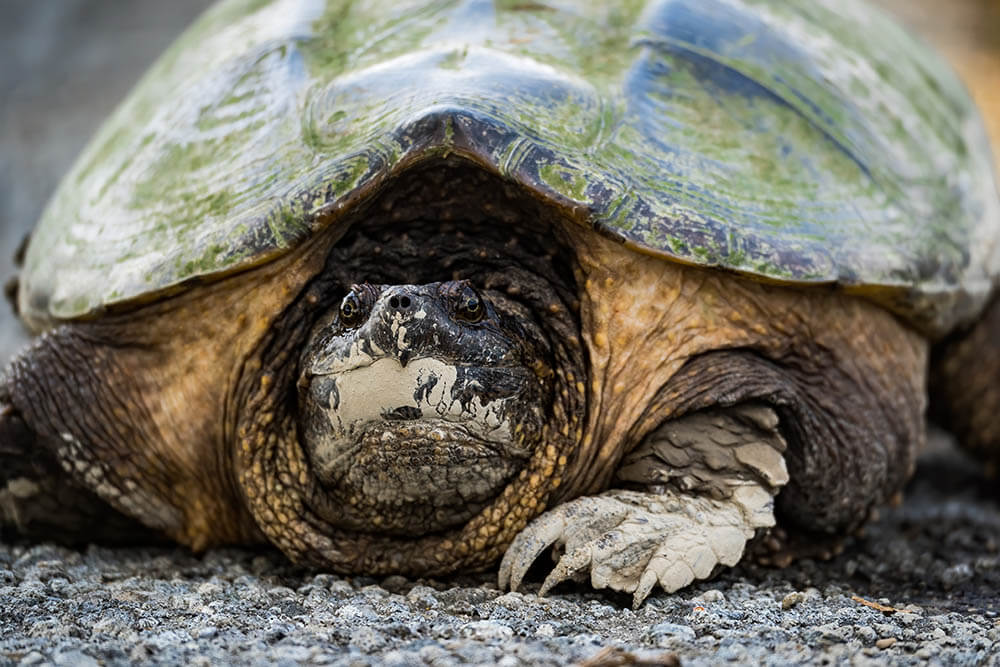
Fascinating Snapping Turtle Facts
Curious about snapping turtles? Read on to learn more about these amazing creatures!
- Snapping turtles are omnivores, which means they eat animals as well as plants. They typically enjoy the meat of insects, worms, small rodents, fish, and crustaceans.
- Snappers can weigh between 200 and 400 pounds.
- Snapping turtles are nocturnal; they’re usually asleep during the day and become active from night to dawn.
- The snapping turtle shell is often covered in algae and mud. As these critters spend a lot of time in the water, such substances end up accumulating on their shell.
- Female snappers are significantly smaller than male snappers.
- A female snapping turtle can lay as many as 80 eggs.
- Snapping turtles reach maturity between 15 and 20 years of age.
- Adult snappers don’t have many predators. However, their eggs and hatchlings are in danger of getting eaten by hawks, great blue herons, and foxes.
- Common snapping turtles generally live from 30 to 50 years. Alligator snapping turtles can have a lifespan lasting 11 to 45 years.
- When it comes to physical appearance, there are many differences between common snappers and alligator snappers. For instance, the former has a smoother shell whereas the latter has a shell with three prominent ridges. Common snappers also boast an oval-shaped head whereas alligator snappers have a triangular head.

Conclusion
Snapping turtles aren’t necessarily dangerous. They’re shy, docile animals that would rather stay as far away as possible from us humans than attack us. To them, we’re the dangerous creatures to be feared and avoided.
However, a frightened, desperate snapper won’t hesitate to bite if it feels it has to defend itself. For this reason, we should leave these reptiles alone and learn the various ways we can limit our contact with them.
